| Главная » Статьи » Патроны |
REVOLUTIONARY BULLET DESIGNS
|
WE WOULD be hard pressed even to speculate who it was that first considered placing a projectile in a closed tube and used a propellant to expel it. And when such a device was first used as a weapon, we cannot even guess. The idea seems to have come to several individuals at about the same time. However, we can follow, in broadest detail the progression of the development of the ballistic projectile as wood gave way to stone, then iron and lead castings. In modem times we have seen a continued progression until today we have several families of exotic bullets, each type designed to suit a particular job. For the purpose of this article, I will define a “bullet” as follows: Any object projected from a tube, which is closed at one end, by generation of gas pressure in the closed end of that tube (behind the bullet). Since this definition includes such objects as potatoes, it is, perhaps, a somewhat broader definition than is generally applied. However, we will disregard less important materials; focusing rather on those of military, sporting and target significance. Further, we will arbitrarily restrict our discussion to single projectile types. While shotguns and their antecedents have always been very important, we will not consider that genre here. Finally, we will necessarily restrict our investigation of modem military projectiles to what is nothing more than a cursory examination. Long before anyone considered the possibility of using propellant powders to project objects from closed tubes as weapons, similar devices were used for pyrotechnic effect. Unfortunately, owing to the vagaries of historical documentation and the deliberate military secrecy imposed upon gun-related subjects throughout history, we cannot know for certain what the first bullet was made of, what it was launched from, what the propellant material was, what it was fired at, the result of that launching, or even when that event occurred. However, considering the era of the invention of blackpowder, the oldest effective propellant known, we would expect that a modification of the simple wooden arrow would have been the first “bullet” ever used. It seems almost certain that the first projectiles fired from closed tubes in anger were constructed of wood. The limitations of such a “bullet” are obvious. The first that comes to mind is limited strength against the forces of acceleration; there are others. No doubt, within a short time after the invention of the firing tube, materials other than wood were tried. A partial listing of those materials would have to include the following: Hardened clay balls, natural and modified stones, stones saboted with wood, and various metallic castings. Metallic castings were chiefly lead and iron and their alloys; copper and its alloys were historically entirely too valuable for use in this application, those materials finding essential uses elsewhere—among them several military applications such as gun barrels. The simple iron ball was among the most successful of early bullet designs. The advantages these offered included ease of proper fit to a given bore, and relative speed, ease and economy of manufacture. Simple casting techniques sufficed to produce high-quality cannon balls. 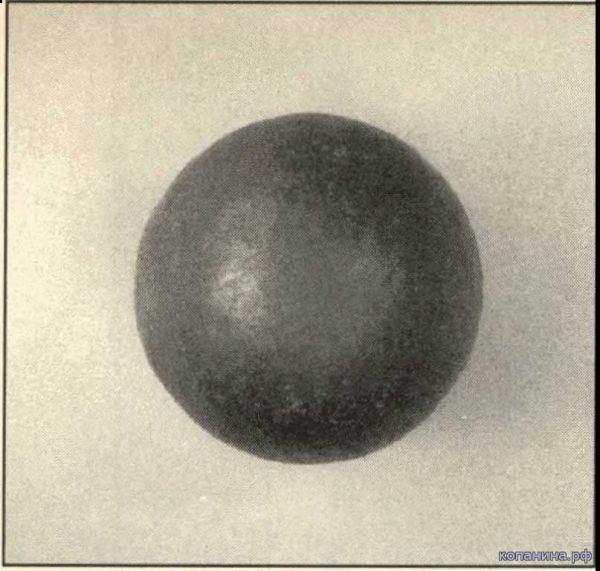 The basic round ball exemplifies the earliest objects fired from guns. Except for wooden dart-like projectiles, which were almost certainly adapted from the crossbow quarrel and were among the earliest of projectiles, the spherical projectile was practically ubiquitous for many centuries after the invention of the gun. In an unrifled bore this is the most accurate, non-dart design. While iron balls were effective against fortifications (among other things), in the early days of cannoneering these projectiles had two significant disadvantages. First, manufacture required sophistication in equipment and skills, a process which was also expensive and time-consuming. Second was a logistical problem of significant importance: An enemy that was also equipped with a properly-sized cannon could potentially recover the spent iron ball and reuse it—no small consideration in a siegelike confrontation. Finally, and most importantly, iron was too heavy. Early cannon barrels were simply not strong enough to withstand the force of blackpowder’s combustion when that force was contained behind an iron sphere. In many regards, lead and lead alloy projectiles were even worse! While lead was much easier, faster and less expensive to manufacture, it was much heavier than iron (about 45 percent). Moreover, lead is much easier to refashion for reuse. For these reasons, lead was simply out of the question for early cannon fodder. Therefore, until the advent of effective shoulder weapons, lead saw little use in single-bullet loadings. For these reasons, fitted stones (which are only about one-fourth the weight of iron) were the material of choice for many centuries; especially in the larger cannons used in siege and counter-siege. In most areas stones were plentiful. Craftsmen who were used to working with stone for construction purposes had the skills and tools needed to modify common rocks to “fit” any given cannon’s bore. Significantly, the rocks thus produced werelikely to shatter on impact—a shattered rock was of limited value to an enemy. Even if the stone did not shatter, it was a common object, and giving one to the enemy represented a small sacrifice compared to the potential damage that “gift” could inflict. Finally, and most importantly, stone was light enough to allow generation of significant projectile energy without producing gun- destroying pressures. On the down side, stone was not particularly effective against heavy fortification; owing to limited mass, stone projectiles simply lacked sufficient penetration potential. Nevertheless, for large cannons, use of iron had to await the advent of sufficiently strong barrels. The Siege of Seville, 1247 ad, appears to have been the first instance of cannon use in battle. (Certainly it is the first recorded instance this author could find.) In that battle, defenders of Seville used cannons firing stones against the enemy. Another recorded instance occurred in 1346 ad. At the Battle of Crecy, small artillery pieces were used by both sides. Almost certainly the projectiles were made of stone. It is interesting to speculate about the invention of the sabot. Sabot is a French term, pronounced say-boe, which means wooden shoe. This is also the basis for our (evidently mispronounced) word, sabotage, which derived from the practice of tossing worn-out wooden shoes in the machinery in an effort to disrupt production. The sabot addressed several of the difficulties and limitations associated with use of stone projectiles. First, use of a barrel-fitting wooden carrier for the stone improved ballistics, compared to the poor barrel seal afforded by a crudely fitted stone. Second, compared to stone, wood is considerably easier to shape. It was much faster and easier to whittle a piece of wood to fit the gun, then hollow it out to accept a crudely shaped stone. This certainly reduced the work required to achieve a good fit in the barrel. Further, if combined with use of a reduced diameter stone, it helped alleviate pressure problems while allowing potentially higher velocities, which equated to greater projectile range. That latter fact is why the sabot is once again on the cutting edge of ballistic technology. A subject we will return to. As noted, in that era, the prime limitation of the gun was strength of the firing tube. The earliest firing tubeswere fashioned of wood. Owing to wood’s very limited tensile strength, these proved to have been rather weak. In an effort to strengthen this basic device, experimenters tried all manner of reinforcement. At first various types of rope, leather and sinew were bound tightly around the tube. Later that practice gave way to iron banding—based upon the existing technology used in water barrel manufacture. Eventually the technology for casting barrels (first copper alloys and then iron alloys) was perfected. This advance allowed use of heavier projectiles and more powerful propellant charges. However, these early cannons were by no means safe. It should be noted that throughout history and until quite recently cannoneers were more often than not capital prisoners that were chained to the cannon: Unless “their side” was victorious in the battle, those men were apt to die at the hands of the “other side.” (It seems as though it might be difficult to assign a favored side for a person in such a predicament.) Nevertheless, since early cannon barrels had an unknown but rather limited life cycle, the biggest threat to a typical cannoneer was barrel failure! Regardless of strength and design limitations of the gun, projectile development was brisk. To place this in perspective, consider this historical note: Only a few centuries after the invention of the simplest gun, Leonardo da Vinci had designed a workable iron cannon ball of considerable sophistication. After traveling a timed distance into its ballistic flight that ball would explode; pieces generated from that explosion would scatter a short distance before exploding; finally, pieces from those secondary explosions would travel a short distance before exploding and creating tertiary shrapnel. Now that is sophistication! Despite the potential, none of the earliest metallic projectiles were particularly successful. Production was simply too costly. By the 14th century, with the development of effective small arms, lead bullets came into wide use. In that era improvements in founding technologies created a niche for iron spheres in medium-sized cannon. However, stones continued to find application in the largest cannons. Here we will leave iron and stone behind. The immediate future of bullets was then clearly defined—lead and its alloys. Lead is a common element found in many locales worldwide. Most commonly it is an ore product of the mineral Galena (PbS). It has been widely known and available since the 8th century вс. Further, lead has long been comparatively inexpensive. Several physical properties render lead an eminently suited base substance for use in small arms projectiles. First, lead is malleable—it deforms under stress without fracturing. This provides for proper bore obturation and eases the loading operation in muzzle-loading arms. Second, lead is chemically stable under atmospheric conditions. This provides for a long shelf life of premanufactured bullets. Third, lead melts at a comparativelylow temperature (it is easy to melt over an open wood flame). Fourth, lead is easy to cast into preshaped objects. These latter two characteristics allow a person with a bit of skill to produce high-quality bullets using only a few modest tools. However, until the advent of rifling, in the late 1400s, lead bullets offered limited ballistic advantage. In fact, even the simple long bow had a much greater effective range! That a lead bullet would carry significant energy over a considerable distance was of little practical value: Unrifled guns were not capable of dependably delivering a bullet to an intended target at extended ranges. Spiraled rifling dramatically changed that situation. The first rifling was not really rifling as we know it at all. In an effort to minimize deleterious effects of blackpowder fouling, early shoulder gun makers began to incorporate deep wide parallel grooves in barrels. These grooves had no twist. There were likely two basic versions of such rifling. The first was intended only as a system to collect fouling and minimize the deleterious effects of powder fouling in the bore. The idea seems to have been that the fouling would move into these grooves as the new bullet was seated. The second system used a bullet designed with a cicumferential rib. This rib was aligned with grooves in the barrel during the loading operation. This design was intended to prevent unintended bullet rotation. Perhaps this improved accuracy. Soon, several enterprising geniuses had a better idea. In that era and for a long period before the development of the shoulder gun, the best cross-bow quarrels (and often long-bow arrows) incorporated a slight twist in the fletch- ing. This modification had long been proven to improve long-range accuracy. It was easy to observe the effect this twisted fletching had on the projectile—rotation. It was certainly a small stretch of logic to suspect that rotation of a bullet might similarly improve its performance. Nevertheless, it seems truly unlikely that those early experimenters could have imagined the ultimate consequences of their invention! In any case, it was a small step from the straight barrel flute to the twisted barrel flute, which became known as rifling. It is no small praise to those who developed this system that every sporting or military shoulder arm that features this device is now known as a rifle. That fact speaks volumes for the overwhelming success of this system. With effective rifling came two significant improvements in gun performance. First, was an increase in accurate range of the simple round ball. Second, was the opportunity for accurate use of elongated projectiles. Both effects pushed the envelope of gun performance into an entirely new arena. By the early 1500s, perhaps a bit earlier, the next major bullet related innovation was established. Despite the substantial advantages this innovation offered, several generations passed before this new technique was fully appreciated and embraced. What was this revolutionary invention? Nothing more than a simple piece of cloth! Where shooters had formerly carried an iron ramrod and a heavy mallet, both necessary to drive the borefitting lead ball down a powder residue-fouled barrel, a 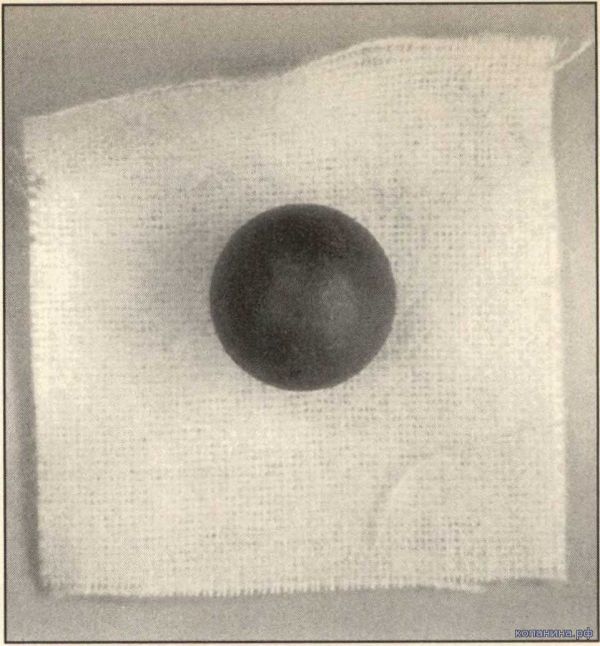 The patched round ball represents the first truly revolutionary single-projectile loading for use in shoulder guns. This device provided a plethora of advantages over the unpatched round ball. The most important include: Faster and easier loading, dramatically improved accuracy and improved external ballistics. Perfected in the early 1500s, the patched round ball is still an effective combination for many applications. In typical rifles it delivers all the accuracy the average shooter can utilize in offhand shooting. simple wooden ramrod would now do the job quite nicely. Further, loading time was dramatically reduced. Best trained shooters can load a patched round ball into a typical muzzleloader in only a few seconds. The old system was a painfully slow process. Further, hammering a lead ball down a bore was wrought with problems. First, it deformed the ball, ruining its balance and potential accuracy. Second, it was bound to eventually damage the gun’s bore, again ruining potential accuracy. Using proper lubricants (various animal fats were preferred) and patched round balls, an experienced shooter could fire and reload his muzzleloader a half- dozen times while the fastest reloaders using an unpatched ball got off only two shots. Further, the patched ball was intrinsically more accurate than the unpatched round ball, even under the best of loading conditions (the unpatched ball necessarily deformed into the rifling and therefore carried ballistics-limiting scars). Consider the magnitude of these differences. On the one side: A shooter firing two well-aimed shots who needs to get within about 100 yards to expect to hit a man-sized target most of the time. On the other side: A shooter firing at least six well-aimed shots who only needs to get within about 200 yards to expect to hit a man-sized target most of the time. One can readily see the sporting and military advantage the patched round ball offered— it is no stretch to call it a revolutionary development (also a delightful pun). The patched round ball was so effective that for hundreds of years after the invention of the rifled barrel (until about 1850) that combination remained the system of choice for almost all shoulder arm applications. This is a truly amazing fact. It is also good to keep in mind that the patched round ball is still an impressive projectile for hunting applications. Typical muzzleload- ers will deliver these bullets somewhat past 100 yards with all the accuracy the average hunter can use in the average hunting situation. The patched round ball for a 75-caliber rifle (0.715-inch diameter—545 grains weight) can easily deliver 1500 foot pounds of energy at 100 yards. As an aside, it is worth noting that the widely distributed lead-based bullet along with shoulder guns that were reasonably affordable had a critical role in the development of freedom for the masses. Prior to those developments, and throughout the development of so-called civilization, any monarch or other man of means could afford to have well-equipped and well-trained mercenaries that were effectively immune to both defensive and offensive efforts of the common man. The advent of the effective gun and bullet reduced the best trained man, suited in the most effective armor, to the equal of any citizen who had an hour to learn proper gun handling and usage. Samuel Colt affected the slogan but he was several generations late of the actual fact: “God created all men; Sami Colt made all men equal.” I would suggest that those who do not believe that the second amendment to 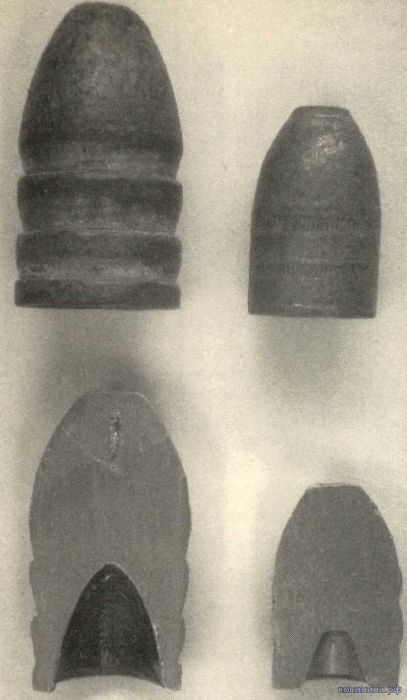 The next revolutionary innovation in small arms bullets is exemplified by the Minie ball. On the left is a 510-grain 58-caliber example. The circumferential grooves ease loading, collect and remove fouling and hold grease to soften blackpowder fouling. The hollow base provides for proper obturation, even if nearly pure lead is not used in the casting. In response to the powder’s blast the bullet swells up to seal the bore and engage the rifling. The Minib ball is the fastest-loading muzzleloader projectile and has much better long-range performance, compared to the round ball. (Note the casting flaw near this dissected bullet’s nose.) The basic Minie style is an effective design. It is still in use in several factory revolver loadings, as exemplified here by Winchester’s 255-grain 45 Colt bullet (on the right). this nation’s constitution was intended to, and still does, deter tyranny should consider this reality of history a bit more carefully. James Watt’s invention of a workable steam engine, in the late 1700s, made extensive underground mining feasible. With that advancement came the first occurrence of widely available lead at an affordable price. The specter of equality was thereupon loosed upon an unsuspecting world order. Consider that blackpowder and lead were two of the chief imports in the New World Colonies. As noted, for many generations the pure lead ball was the projectile of choice. It worked well in both smoothbore and rifled guns. The raw material was affordable. It was malleable, easy to cast and stayed reasonably true in flight (accurate and predictable). In that era those wanting more power simply used a gun with a larger bore. However, with the advent of rifling the possibilities of the bullet expanded into an entirely new dimension. The next significant innovation is epitomized by the Minie ball, a hollow-base elongated bullet named after С. E. Minie, a French officer bom in 1814 and who died in 1879. His name was pronounced Min-e-yeh. Rather than chronicle all the contemporary competitive designs we will look at what the Minie ball was and what it does. There were several problems associated with the use of elongated bullets. Foremost was the deleterious accuracy and reloading effects of fouling. Attempts to adapt the cloth patch to an undersize elongated bullet were bound to fad. Simple geometry demonstrates that a simple equal thickness patch cannot uniformly surround an elongated bullet shank in a gun’s barrel. The solution was to use a bullet that only loosely fit the gun’s bore. When the powder charge exploded behind the projectile, the malleable lead upset. It thereby properly obturated the bore and engaged the rifling. This ameliorated the problems of fouling, eased the loading task, reduced dimensional control concerns and provided the requisite accuracy. The Minie ball also represented the fastest loading muzzleloader projectde. Not insignificantly, it also provided a useful increase in effective range. Compared to a round ball, it easily delivered more than three times the energy at the longest feasible ranges. The basic design incorporated a hollow base cavity intended to reduce the force necessary to expand the bullet to fill the rifling. This feature also eased loading into slightly undersize or badly fouled barrels. It is worth noting that the purity of lead was a considerable issue. Had very pure lead been routinely available the Minie,’s hollow base would not have served any significant purpose. As it was, the low alloys that were available were often hard enough that without the hollow cavity the ball was not certain to swell sufficiently to properly obturate the bore in response to the powder’s explosion. The second design feature shared by all Minie balls were concentric grooves in the shank. These served three significant purposes. First, they held grease, which softened powder fouling in the bore and eased seating by simple reduction of friction. Second, they reduced the force necessary to start an oversize bullet into the barrel—less contacting surface area and an area where bullet material could easily deform into. Third, they provided a place for some of the powder fouling to accumulate and thereby be removed from the bore as the bullet was fired. This type of bullet carried the bulk of applications through the advent of the self-contained cartridge, when other designs gained an edge as state-of-the-art projectiles. We should note that several current factory smokeless loadings use what is essentially a Minie ball. An example is Winchester’s 255-grain 45 Colt loading—in many quality revolvers this antique bullet design still delivers cutting-edge accuracy. I have seen several lots of 255-grain Winchester 45 Colt ammunition that easily produce ragged one-hole groups at 25 yards when fired from the best made revolvers. Woe be the novice handloader who tries to duplicate that accuracy with any typical cast or jacketed bullet. While it can be done, it is no simple task. The next significant innovation was the paper patched bullet. While this design was tremendously successful in highly specialized muzzle-loading target rifles, it found limited practical use. With perfection of the metallic cartridge as a viable self-contained unit, paper patching gained a foothold. The first effective application involved precisely two layers of moistened rag paper, wrapped around the bullet’s shank. A slight excess of paper behind the shank was twisted and folded over the bullet’s base, or into a shallow hollow cavity in the bullet’s base. Loading a paper patched bullet into a cartridge case was quite simple and provided a robust round of ammunition that could deliver surprising accuracy, even by today’s standards. There are several reasons the paper patched bullet then offered (and still does offer) superior accuracy potential. First, it eliminated the need for any complicating bullet features. With the paper patch, all that was required was a cylindrical section and a flat or slightly hollow base—good bullets were easier to cast. Second, such bullets could be swaged—swaged bullets can be more perfect, compared to cast bullets. Equally, the paper patched bullet offered superior ballistics. Necessary lubrication grooves on an unpatched bullet significantly increase a bullet’s wind resistance. This both reduces effective range and increases windage and elevation judgment errors. Entire books have been written on the subject of the paper patched bullet. Here, we will suffice to say that this design is still among the very best! Many shooters use modem magnums loaded with smokeless powder to propel heavy paper patched bullets to 3000 fps with sub-MOA accuracy. Nevertheless, the paper patched bullet has limitations. First, it is time-consuming to manufacture, and formerly the process did not lend itself to automation. (However, modem computer-controlled servo-based equipment could change that!) Second, exposed paper in a paper patched cartridge is vulnerable to handling damage and deterioration. The advent of smokeless powder indirectly led to the general abandonment of the paper patched bullet. The problem did not relate to any particular limitation of the paper patch but, rather, to the fact that, for the first time, smokeless powder suggested a shelf life concern for the paper patch! Formerly, since blackpowder is notoriously hygroscopic, ammunition was not expected to survive years of storage. That fact explains the early adoption of headstamp date markings on military ammunition. The armorer had to know how old a cartridge was, a month and year stamp gave him that information. The fact that the month was included suggests just how long ammunition was expected to survive after production! On the other hand, it was soon realized that smokeless powder loads could survive for many years, even decades, given only a reasonable measure of careful storage and handling. As an example of this fact, consider several lots of pre-WWI German 8x5 7 mm ammunition that was recently tested: Ballistics and accuracy were essentially equivalent to the best modern 8x57mm ammunition. Fired from original military rifles, those loads generated practically the full rated 2880 fps with their 154 grain bullets. The realization of extended shelf life potential and the need for a more easily produced patched bullet drove the demand for an alternative. Simplicity, ease of production, accuracy potential and low cost suggested the unpatched lead ball. However, it was soon realized that no amount of alloying, oven hardening or other special treatments could render the unpatched lead bullet suitable for use in full- power smokeless cartridge loads. Barrel leading and loss of accuracy were the chief complaints. Several harder and higher melting point malleable metals and alloys were tested as bullet jacket materials. That is an over simplification. Truth is, practically eveiy- thing was tried. For several decades the two big problems in gun technology were: How to make barrels strong enough to withstand the pressures that smokeless powder can generate and effectively use in accelerating a bullet; how to make bullets that will function properly at that pressure level. With the German invention of nickel steel late in the 1800s which resulted as an indirect consequence of prosperity the German industry gained from a patent on brilliant aniline-based fabric dyes), the first problem was solved. Where chamber pressures in the upper blackpowder regime, perhaps about 30,000 psi, had been the practical limit, nickel steel allowed working pressures safely exceeding 60,000 psi. As noted, many metallic patching substances were used. However, a simple alloy of 95 percent copper and 5 percent zinc, known as gilding metal, won the day. This is still the primary material for use in small arms bullets of all types. The gilding metal jacket is easy to produce and manufacture into finished bullets. The core material can be lead alloy, steel or some more exotic substance. Gilding metal provides an insulating layer between the bullet’s core and the barrel steel. Metallic fouling is sufficiently reduced to 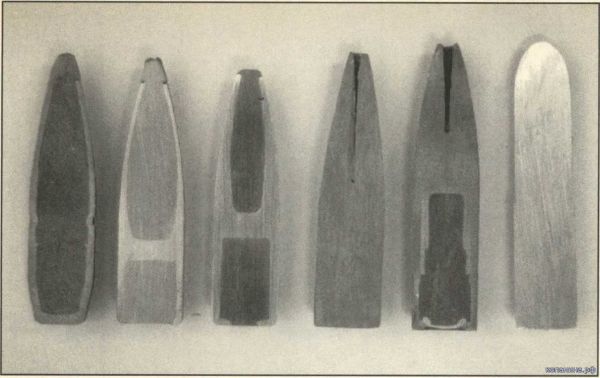 Various modem bullets, dissected to show structure, left to right: Conventional jacketed, Homady 30-caliber 165-grain SPBT; conventional Nosier Partition 30-caliber 165-grain spitzer; bonded partitioned, Swift 30-caliber 165-grain Spitzer; expanding solid, Barnes 30-caliber 165-grain X bullet; expanding modified solid, Winchester 30-caliber 180-grain FS; non-expanding solid, Barnes 27-caliber 150-grain homogenous RN. This suggests several significant limitations in the basic jacketed bullet design. First, there is the potential for the jacket to separate from the core. Second, there is the potential for the core to fragment. Third, and related to the first two problems, if the bullet features sufficiently strong construction to avoid separation or fragmentation, there is a high probability that it will fail to expand. This has always been a catch-22 situation. Nevertheless, mainstream manufacturers have perfected the art and bullet failures are quite rare—nevertheless, they do occasionally occur. A particularly effective mitigation used by several hunting bullet manufacturers is quite basic. The bullet’s core is literally soldered into the jacket. Combined with the use of a pure copper jacket and a low-alloy lead core, this technique produces a bullet that is more apt to expand on soft impacts but that is also less apt to disintegrate on the hardest impacts and will typically lose less weight while expanding the same amount. Use of pure copper for the bullet jacket does significantly increase metallic bore fouling but this seems a small price to pay for a superior hunting bullet. As is common with all hunting bullets, jacket thickness and several other characteristics are carefully controlled to maximize terminal performance. A recent innovation is the plated bullet. Speer (and others) have perfected a process whereby a low percentage alloy copper jacket is electro-chemically plated onto a nearly pure lead core. Speer is using this design for all of their high-performance (Gold Dot) pistol and revolver bullets and a new 30-30 loading (Nytrex). The electro-chemically plated jacket design affords several advantages. First, it provides for innovative application of hollowpointing, jacket nose pre-stressing and core precutting. This allows precise control of expansion characteristics with maximum dependability. Second, it practically eliminates the potential for any sort of jacket core separation. Third, it facilitates testing of new bullet designs with a minimum of expenses. Norma Precision has adopted a bonded cone in a line of high-performance hunting bullets in factory ammunition. This new Oryx line is intended to provide the most 8th Editiondependable hunting performance possible and at a price that is competitive with standard unbonded gilding jacketed hunting bullets. One obvious method to mitigate the potential for failure to expand or failure to hold together is the partition bullet. The German H-Mantle was developed early in this century, it appears to have been the original partition bullet. In 1948, John Nosier produced the first of his now famous Partition bullets. The original design incorporated bronze and several manufacturing steps not common to the simple jacketed bullet. Modem production is quite advanced and Nosier Partition bullets offer an impressive combination of hunting performance, accuracy and economy. Several other manufacturers now offer partitioned bullets of various types. Regardless of who makes it, the materials used or any manufacturing peculiarities, the Partition bullet incorporates one basic feature: A solid partition made of the same material as the bullet jacket which separates the nose section from the tail section. This feature is typically made of copper or gilding metal and is sufficiently thick to prevent any disruption of the bullet’s nose section from propagating to and disrupting the bullet’s tail section. A typical partitioned bullet features a low-percentage alloyed (soft and malleable) lead nose core, a higher percentage alloyed (harder and less malleable) lead base core and a copper alloy jacket featuring specially controlled jacket thickness and heat treatments. The partitioned bullet offers one significant benefit: It can be made soft enough in the nose section to practically guarantee a reasonable degree of expansion without the potential for complete failure. However, with this advantage comes a down side: Unless steps are taken to bond the nose core to the jacket and thereby minimize jacket fragmentation, the bullet’s nose is very apt to substantially disintegrate during hard (heavy bone) impacts at high velocity. One method of reducing this potential is now used in the Swift A-Frame bullet. A pure lead nose core is soldered into a pure copper partitioned jacket. Here we have a bullet that is practically immune to disintegration failure. At the same time the A-Frame can provide superior expansion potential, even in the “softest” of impacts. Like any other pure copper bullet, increased metallic bore fouling is an issue, albeit a small consideration to the dedicated hunter and one which moly-coating can eliminate. The Swift Bullet Company set up shop in April 1984, when they produced their first A-Frame bullet. As was true of John Nosler’s first production, this was a “basement operation.” Original A-Frame bullets were made just as they are today, except for a slight difference in the finished partition. The original bullets had a small central opening; improved equipment allows elimination of that hole. The partition was also moved farther forward. The original Swift A-Frame bullet was a 375-caliber, a logical choice since Nosier was not then offering a Partition bullet in 375. In an effort to find a superior hunting bullet for their new 416 Magnum, Remington tested Swift’s 416 bullet, which is designed to open as fast as possible while limiting expansion and retaining almost 100 percent of its weight. 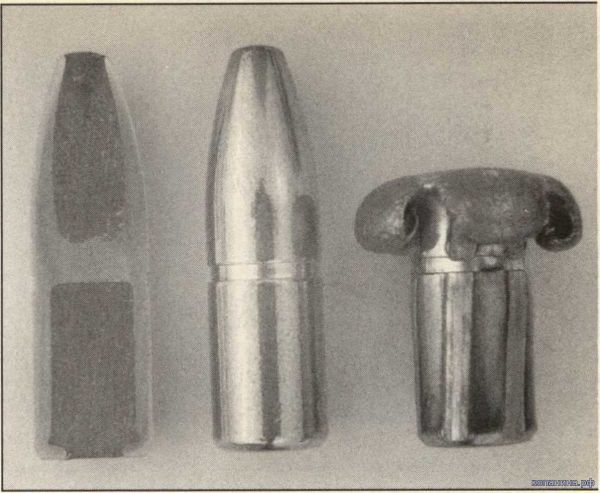 The 375-caliber 300-grain bonded partitioned bullet was Swift’s first offering. This bullet design combines reliable expansion and high weight retention. Use of pure copper and lead is fundamental to the success of the A-Frame bullet. These substances are more malleable than the alloys used in non-bonded bullets. Bonding is the key: without bonding, pure copper and lead are unlikely to withstand the stress of impact and bullet failure is likely. The copper supports the lead and the lead retains the copper! Their results prompted Remington to choose the A-Frame for use in all Remington Safari grade ammunition loaded with expanding bullets. As we have seen, several innovations, intended to mitigate the limitations of the gilding jacketed lead-alloy cored bullet, have been developed to a high level. This fact suggests a limitation of this basic bullet design. Lead and its malleable alloys are simply not up to the task of withstanding the worst types of impacts with game animals. While the target bullet is still a typical jacketed lead- alloy cored bullet, hunting bullets have moved beyond lead and its alloys. The solid copper or copper alloy hunting bullet, as exemplified by the Barnes X and the modem Barnes solid, promise new vistas in terminal performance. The simplest of these bullets is the solid. The Barnes solid is representative of an entire genre of homogenous solid bullets. Typically these are lathe-turned out of brass. Compared to any of the jacketed non-expanding bullet designs, homogenous solids have one important advantage. Such a bullet is practically immune to deformation resulting from any impact with a dangerous game animal. Since these bullets will not deform or fragment, terminal performance is predictable. The Barnes X gets its name from the characteristic shape of the expanded bullet—when seen “nose on” it forms an obvious X. These expanding bullets are made of essentially pure copper with tightly controlled metallurgical properties and a specially shaped hollow point that includes precut internal flutes in the bullet’s nose. These flutes facilitate expansion and are an important part of how the X bullet works. During manufacture, a length of copper wire is formed through a series of dies to the final shape. In the process, 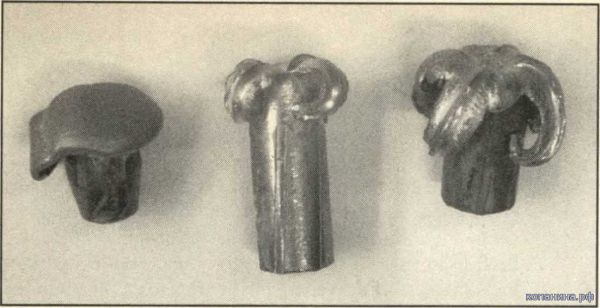 Representative expanded bullets, left to right: Hornady 30-cal- iber 165-grain SPBT after high-velocity impact; Barnes 30-cal- iber 165-grain X after moderate-velocity impact; same bullet after high-velocity impact. (Below) Zinc is useful for indoor shooting. It casts well and produces little metallic fouling, even at high velocity. Shown, left to right: 87-grain 38-caliber (from a mould that casts 140- grain lead-alloy bullets); 95-grain 38-caliber (from a mould that casts 158-grain lead-alloy bullets); 142-grain 45-caliber (from a mould that casts 230-grain lead-alloy bullets). 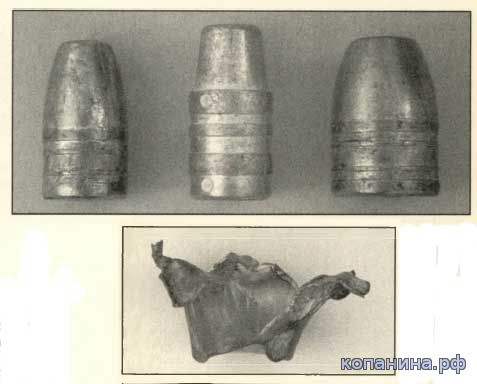 Jacket/core separations are quite common in conventional jacketed bullets. This 44 Magnum bullet jacket typifies one limitation of this bullet design. Rifle bullet manufacturers have incorporated all manner of modifications to reduce this tendency, and with good success. However, separations and fragmentation are endemic to the basic design. 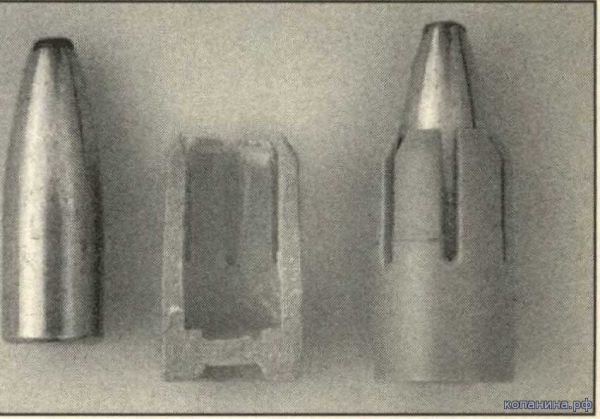 Remington 30-06 Accelerator bullet and sabot. The plastic sabot carries a 22-caliber 55-grain bullet. The fingers at the sabot’s nose open at the muzzle and the sabot is stripped away from the bullet by wind resistance—an approach both old and new! 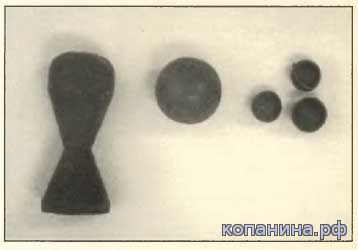 Rubber projectiles find application in riot control. These so-called non-lethal projectiles are quite dangerous and are offered in 12- gauge police loadings. (Left to right) 89-grain dart; 56-grain ball; 8.3-grain buck; 4.2-grain buck. the nose is hollowed to the finished depth with a specially shaped fluted punch. The bullet nose is then reclosed to the final spitzer configuration. The formed hollow point typically reaches the full length of the bullet’s ogival nose section. As finished, the bullet has a tiny deep hollow point. The nose is solid on the outside but separated into (usually) four sections by parallel longitudinal cuts extending from the hollow point hole almost to the outside. Upon impact, hydraulic forces open the bullet’s nose through bending. Compared to a conventional softpoint bullet, the physics of expansion is fundamentally different in the X bullet. In the former, the core and jacket have to expand through malleable deformation. In the latter, expansion is primarily achieved through the action of bending open the individual bullet nose petals. This is more than just a matter of semantics. Bending requires much less energy, compared to malleable deformation. More importantly, this characteristic makes it possible for the X bullet to expand at lower velocities than a conventional deforming bullet will. Further, the relatively high strength and malleability of copper allows the X bullet to expand without failure at higher impact velocities than most conventional bullets can withstand. As a result the X bullet will expand reliably across a wider velocity range and against a wider range of resistance than any conventional bullet. Further, the X will retain practically 100 percent of its impacting mass almost every time. Also, the X creates less frontal area for any given degree of maximum expansion (the areas between the petals is not included) while, at the same time, generating more length along that front. This provides for superior penetration with greater wounding effect along every inch of penetration! The latest advancement in bullet technology is the tungsten alloy cored target bullet, under development at Powell River Laboratory. These bullets offer two significant advantages. First the tungsten alloy core is harder than a lead core. This reduces the upset that occurs as a result of stresses imposed in the firing process. Second, the tungsten alloy core is significantly heavier (length-for-length) compared to a lead alloy core. This latter effect provides for a reduction in velocity loss across any given range. For a variety of reasons it also dramatically reduces wind deflection. At long ranges this latter benefit is substantial. Owing chiefly to this advantage, it is very likely that despite the very high cost, these bullets will find increasing application in long-range target competitions. As an added bonus tungsten bullets also offer the potential for increased muzzle velocity with any given bullet weight. They occupy less room in the case and do not slug up as much in the barrel which reduces velocity-robbing bullet-to-bore friction. Regarding recent developments, we find the muzzle- loader revisited by modem bullet manufacturers. In this instance, we again find Bames Bullets at the forefront. They have adapted a modification of their X bullet design for use in blackpowder muzzle-loading guns. These purecopper saboted bullets achieve startling ballistic uniformity and can bring a new level of performance to the old smokepole. Not the least of the advantages these bullets provide is a significant reduction in recoil for the level of terminal performance achieved. As we close, we find ourselves getting back to where we started. The most sophisticated modem gun fires a nonrotating saboted quarrel-shaped bullet out of a smooth bore! These projectiles rely on aerodynamic stability to achieve accuracy. Some of the most effective projectiles fired from these guns rely entirely upon the delivery of huge doses of kinetic energy to do the job on the intended target. Other versions include sophisticated charges of high explosives. Muzzle velocities can exceed 6000 fps. Some versions use a comparatively small diameter depleted-uranium dart. These slender projectiles can accurately deliver the vast majority of the muzzle energy across ranges exceeding one-mile. Upon impact with any hard object, bullets at that velocity create intense heating, which is often sufficient to indirectly destroy an armor-plated tank through ignition of munitions within. If, as seems most likely, the first bullets were indeed simply quarrels borrowed from the crossbow and intended to puncture through armor plate, it is something of an irony that the latest high-technology bullets are essentially similar in design and purpose. | |
| Просмотров: 1394 | | |
| Всего комментариев: 0 | |